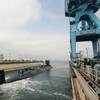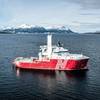The U.S. Navy has awarded a team that includes Austal USA, a $9 million contract to develop
a preliminary design for the Littoral Combat Ship (LCS). This selection means that of the 6
original teams competing for these awards, the team that includes Austal USA is one of three
teams that was down-selected in the competition to build the first two ships of this class.
With its expertise in large, high-speed aluminum vessels, Austal, as the designer and builder of
the proposed LCS vessels, is a major contributor to the team, which is led by General
Dynamics-Bath Iron Works. The team’s proposal for the Littoral Combat Ship (LCS) is based
on Austal’s unique 126 meter high-speed aluminum trimaran hullform.
Austal USA’s CEO, Greg Metcalf, made the following statement regarding the good news,
“This award is a major accomplishment in Austal USA’s plans to become a major competitor in
high speed applications for the US defense program.”
Bob McKinnon, the managing director of Austal Limited, Austal USA’s Australian parent
company, said the contract was an important step forward along the path to an increased role in
the global military vessel market.
“The significance of moving into the next stage of the LCS project goes beyond the obvious of
being a step closer to playing a major role in what is shaping as a multi-billion dollar, multi-year
project,” Mr. McKinnon said.
“Selection of the trimaran for the next stage of this project confirms that aluminum is an
appropriate choice for ships, even in combat roles. This is clearly important for other future
defense contracts,” he said. The flexibility, speed, endurance, volume, seakeeping, payload
capacity, and maneuvering characteristics of the trimaran, coupled with modular mission
packages and other modifications to address military specific requirements, provide an optimal
solution for the Navy’s LCS requirements.
Mr. McKinnon said participation in the high-profile LCS project is increasing international
awareness not only of Austal’s capabilities but also the great potential for high-speed vessels in
a variety of defense applications.
Following completion of the seven-month LCS preliminary design stage, the Navy will select
two builders, one or both of whom will build the first two ships. The first vessel will commence
construction in early 2005 and the other in early 2006. Plans also call for the additional
construction of three ships in 2008 and four in 2009.
The Navy predicts that up to 60 Littoral Combat Ships may eventually be required. In
accordance with US law, all vessels will be built in the United States.
Sponsored Content
Safer Starts Here: Build Ships, Protect Crews

Featured videos

Corn Belt Ports Streamlines Critical Agriculture River Shipments

Cat Pushes Forward on Hybrid Electric Solutions, Alternative Fuels

“One Man, One Wrench” Launched a Global Maritime Power Play
July 2025
 Read the Magazine
Read the Magazine

 Read the Magazine
Read the Magazine
This issue sponsored by:

Deep Strike: Seabed Warfare Will Target More Than Cables and Pipelines
Subscribe for
Maritime Reporter E-News
Maritime Reporter E-News is the maritime industry's largest circulation and most authoritative ENews Service, delivered to your Email five times per week







